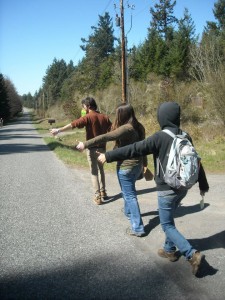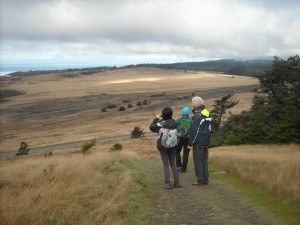Erroneous Forecasts
Fortunately we have been able to spend a large proportion of our time this week outside basking in the Washington sunshine. Although thunderstorms were predicted at the beginning of the week, the forecasts seem like a distant memory. Many hours have been spent this week staring out across Haro Strait in search of the ever elusive whales. We know that they are out there because we can hear them on the hydrophones. A few fortunate folk have even caught glimpses of them as they have passed by nearby inlets (not us).  Throughout the San Juans, there is a network of researchers, whale watching boats, and whale heads who keep tabs on the whales and there whereabouts. It is only going to be a matter of time before we see them for ourselves (I can feel it).  Today, there were sporadic reports of transients throughout the Strait, and so a few of us decided to try and hitch a ride across the island to Lime Kiln. Hitch hiking is apparently a popular and efficient way to get around the island. In fact, there are designated pick up areas specifically for hitch hikers. It did not take long before the first vehicle stopped for us. On arrival to Lime Kiln we were greeted by an influx of tourists who were making the most of their Easter Weekend. Sadly no whales.  We did however spot one river otter foraging in the shallows. We were later joined by other students from FHL (mostly the Zoobot crowd). As we imparted our whale knowledge with the Zoobots, they in turn shared facts about various intertidal invertebrates. Such an interesting crowd!
We also explored numerous locations on the south side of the island including Cattle Pass, and South Beach. Cattle Pass is a really unique site where the shallow sea floor forces great quantities of water through a small channel. Thus, the area experiences strong currents which attract an array of sea birds and marine mammals. We were able to test out our birding skills from land-based observations (we still need a bit of work on identifying certain species). Another great reason for visiting Cattle Pass was that it was referenced in one of the papers we were required to read for this week. In addition, to get better views (180 degrees) of the surrounding area, we hiked up Mount Finlayson. This got me thinking about how great of a vantage point the hill would be for viewing whales as they swam by. Â On the evening, we returned to the south side of the island to have a bonfire with some friends. The full moon cast its beautiful hues over the beach and out across the water. Splendid evening!
On the academic front, we were given the opportunity to present on a paper that identified bottom-up effects. At a basic level, ‘bottom-up effects’ refers to how the population density of a resource affects the population density of that resources’ consumer. Although most people chose to present on marine-related issues, I wanted to focus on a terrestrial case study. My paper was titled ‘Bottom-Up Effects on Persistence of a Specialist Predator: Ant Invasions & Horned Lizards’. This paper discussed in detail the effects of invasive species on native populations. In my selected case study, a population of coastal horned lizards was being impacted by the introduction of the Argentinean ants to the area. These ants were destroying and out competing the ‘normal’ food source of the lizard. The lizards are ‘sit and wait predators’, and have highly specialized diets. Because of this, they cannot, or are unwilling, to switch to an alternative food source. On reading this, I couldn’t help but notice the similarities between the horned lizards and the SRKW who depend on one species of salmon, the Chinook, despite the abundance of other species in the area. A second paper I discussed this week was titled ‘Management Effectiveness of the World’s Marine Fisheries’. This paper sought to evaluate how management affects fishery sustainability. I was particularly interested to read how sustainability was defined, and also how it was measured. The blend of science and policy made for a good paper. On the topic of good papers, Andrea Buckman and Cara Lachmuth (DFO Scientists) came in to present on their past research. Cara’s presentation on ‘Killer Whale Exposure to Engine Exhausts’ raised some interesting questions, highlighted gaps in existing data, and drew attention to potential areas of future study. The two guest lecturers also sat in on our weekly mentor meetings, offering advice and giving examples of how we can expand on our final research projects. This was greatly appreciated!





 Twitter
Twitter LinkedIn
LinkedIn Facebook
Facebook